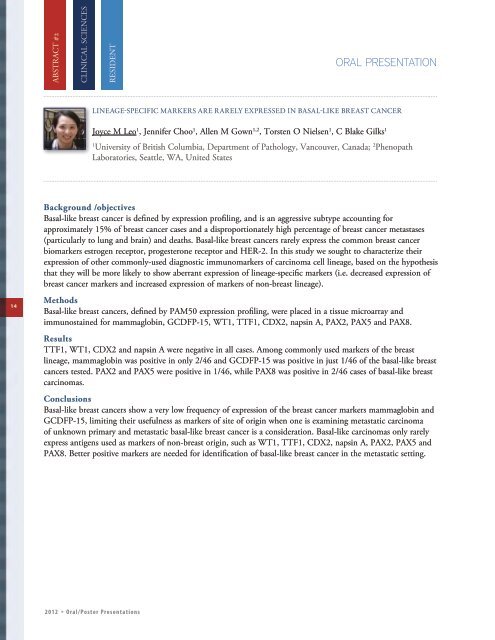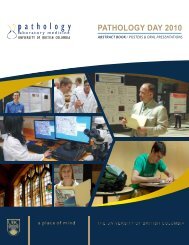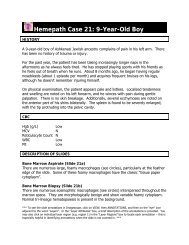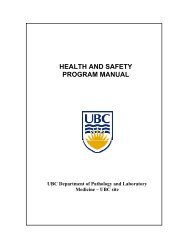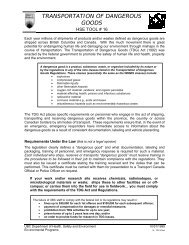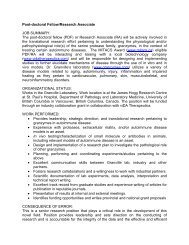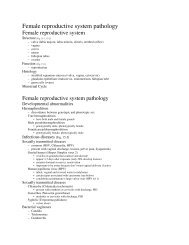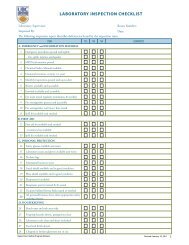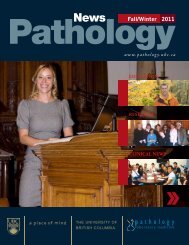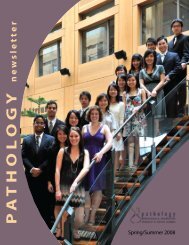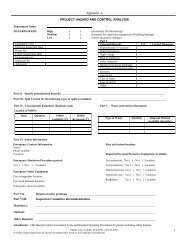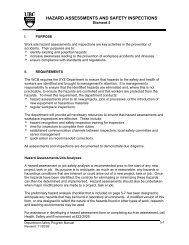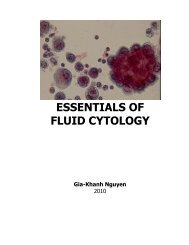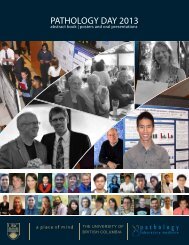Abstract Book - Pathology and Laboratory Medicine - University of ...
Abstract Book - Pathology and Laboratory Medicine - University of ...
Abstract Book - Pathology and Laboratory Medicine - University of ...
Create successful ePaper yourself
Turn your PDF publications into a flip-book with our unique Google optimized e-Paper software.
ABSTRACT #2CLINICAL SCIENCESRESIDENTORAL presentationLineage-specific markers are rarely expressed in basal-like breast cancerJoyce M Leo 1 , Jennifer Choo 1 , Allen M Gown 1,2 , Torsten O Nielsen 1 , C Blake Gilks 11<strong>University</strong> <strong>of</strong> British Columbia, Department <strong>of</strong> <strong>Pathology</strong>, Vancouver, Canada; 2 PhenopathLaboratories, Seattle, WA, United StatesBackground /objectivesBasal-like breast cancer is defined by expression pr<strong>of</strong>iling, <strong>and</strong> is an aggressive subtype accounting forapproximately 15% <strong>of</strong> breast cancer cases <strong>and</strong> a disproportionately high percentage <strong>of</strong> breast cancer metastases(particularly to lung <strong>and</strong> brain) <strong>and</strong> deaths. Basal-like breast cancers rarely express the common breast cancerbiomarkers estrogen receptor, progesterone receptor <strong>and</strong> HER-2. In this study we sought to characterize theirexpression <strong>of</strong> other commonly-used diagnostic immunomarkers <strong>of</strong> carcinoma cell lineage, based on the hypothesisthat they will be more likely to show aberrant expression <strong>of</strong> lineage-specific markers (i.e. decreased expression <strong>of</strong>breast cancer markers <strong>and</strong> increased expression <strong>of</strong> markers <strong>of</strong> non-breast lineage).14MethodsBasal-like breast cancers, defined by PAM50 expression pr<strong>of</strong>iling, were placed in a tissue microarray <strong>and</strong>immunostained for mammaglobin, GCDFP-15, WT1, TTF1, CDX2, napsin A, PAX2, PAX5 <strong>and</strong> PAX8.ResultsTTF1, WT1, CDX2 <strong>and</strong> napsin A were negative in all cases. Among commonly used markers <strong>of</strong> the breastlineage, mammaglobin was positive in only 2/46 <strong>and</strong> GCDFP-15 was positive in just 1/46 <strong>of</strong> the basal-like breastcancers tested. PAX2 <strong>and</strong> PAX5 were positive in 1/46, while PAX8 was positive in 2/46 cases <strong>of</strong> basal-like breastcarcinomas.ConclusionsBasal-like breast cancers show a very low frequency <strong>of</strong> expression <strong>of</strong> the breast cancer markers mammaglobin <strong>and</strong>GCDFP-15, limiting their usefulness as markers <strong>of</strong> site <strong>of</strong> origin when one is examining metastatic carcinoma<strong>of</strong> unknown primary <strong>and</strong> metastatic basal-like breast cancer is a consideration. Basal-like carcinomas only rarelyexpress antigens used as markers <strong>of</strong> non-breast origin, such as WT1, TTF1, CDX2, napsin A, PAX2, PAX5 <strong>and</strong>PAX8. Better positive markers are needed for identification <strong>of</strong> basal-like breast cancer in the metastatic setting.2012 * Oral/Poster Presentations


